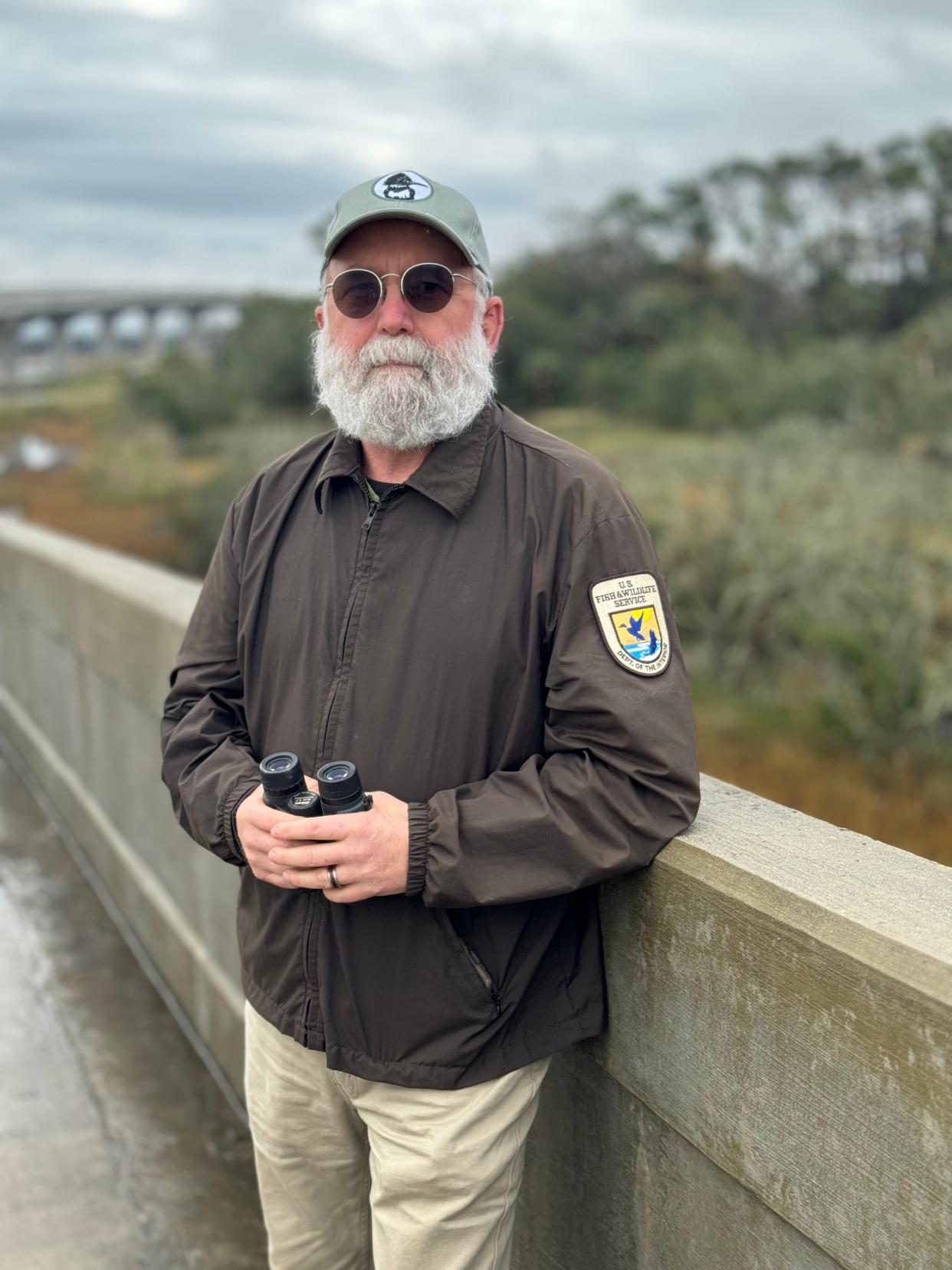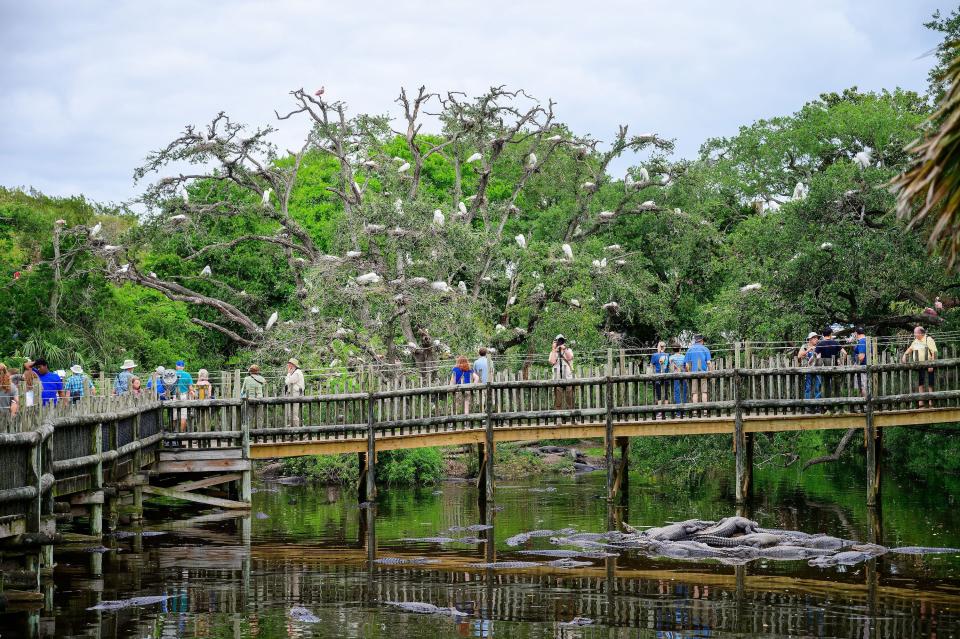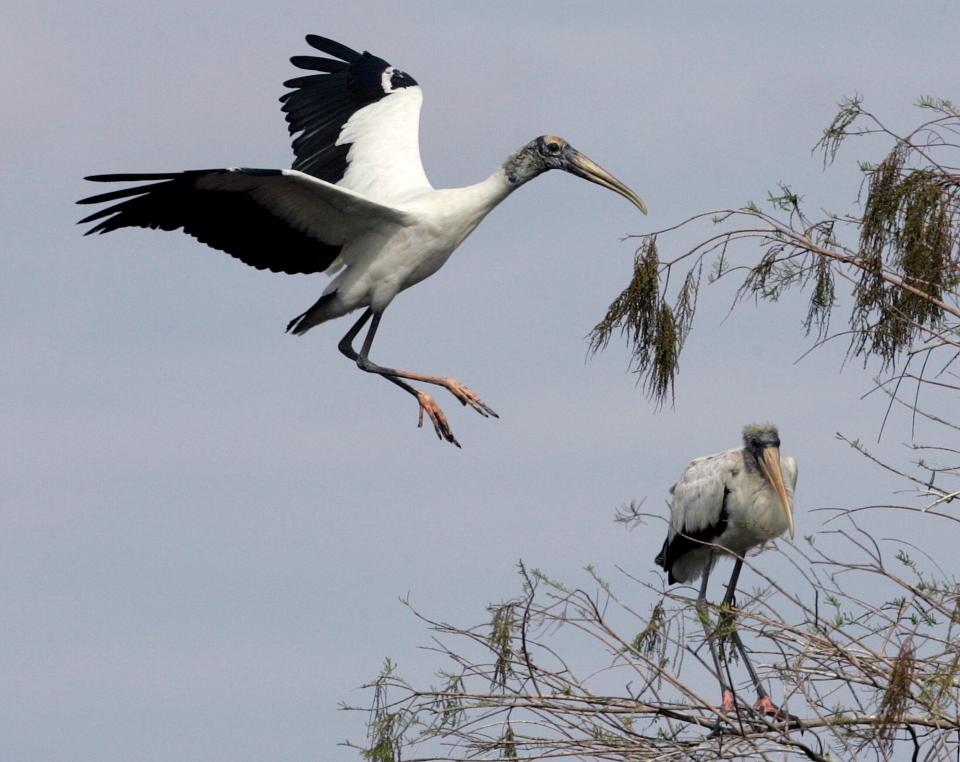Mark Woods: Jacksonville biologist helps deliver this Endangered Species Act success story

In the wake of the 50th anniversary of the Endangered Species Act, it seemed fitting to ask Billy Brooks to take me on a bit of wild goose chase — or, to be more precise, a wild stork chase.
Brooks, 62, is a U.S. Fish and Wildlife Service biologist, working out of the Jacksonville field office.
He started his conservation career 40 years ago, working with sea turtles on Bald Head Island in his native North Carolina. Manatees brought him to Florida. He helped write their recovery plan and start the right whale program before getting involved with plants and birds.
For more than 20 years, he has been shepherding the recovery of the wood stork — a big, long-legged wading bird that in the 1980s was feared to be on a path to extinction.
You’ve probably seen wood storks in Northeast Florida. If you’re like me, you take that for granted. But you shouldn’t.
The Endangered Species Act, which became law on Dec. 28, 1973, has had many success stories in the last 50 years. Bald eagles, American alligators, gray wolves, peregrine falcons.
Wood storks are one of those stories. And their story has some pivotal — and lasting — chapters in Northeast Florida.
“When I first came here,” Brooks said, “seeing a wood stork in Jacksonville was a bit of a rarity.”
Eagles, herons and more
It was a recent cold and rainy morning. To stay dry, we were standing under the bridge that goes over Sisters Creek, near the Jim King boat ramp off of Heckscher Drive.
When the wood storks start nesting in Northeast Florida in the next couple of months, it will be fairly easy to find places to see them. There are three longtime colonies in our area: at the Jacksonville Zoo and Gardens, the St. Augustine Alligator Farm Zoological Park, and on private land near San Pablo Creek.

But right now, it isn’t always easy to see them.
Brooks had looked at the tides and mentioned some possible spots, like the marsh at the north end of Talbot islands or some city-owned wetlands near Cecil Commerce. But when he scouted out those locations, he didn’t find any. So he suggested trying this spot.
Within minutes, he spotted a large bird soaring toward one of the nearby pine trees.
“See the eagle,” he said.
It landed high in the tree. Above it, perched atop the tree, was a large nest with a large bird on it.
“A great blue heron,” he said. “They’re the first to nest.”
While we kept an eye out for wood storks, Brooks began to tell some of their story.
A path to extinction?
Once upon a time, back before humans really messed up the Everglades — for the record, that’s my description, not the official words of a wildlife service biologist — South Florida was the primary nesting place for wood storks. Every year it would be teeming with them, creating quite the spectacle.
“There were these giant what we call ‘super colonies’ with more than 1,000 pairs,” Brooks said.
In total, it’s estimated there used to consistently be more than 20,000 nesting pairs a year. But the ditching and draining of the Everglades changed that. By the 1960s, the nesting population was down to about 10,000 pairs. And in the early 1980s, John Ogden — an ornithologist for Everglades National Park and the National Audubon Society who is considered one of the key figures in the restoration of the Everglades — wrote a letter to the Fish and Wildlife Service.
“He said that if this trend continues, one might predict the wood stork would be extinct by the turn of the century,” Brooks said.

In February 1984, when the only species of stork breeding in the United States was placed on the endangered species list, there were under 5,000 nesting pairs.
Thirty years later, in 2014, the status of the wood stork was upgraded from endangered to threatened. And now, 40 years after the initial listing, the wood stork could be removed from the list. That’s what the Fish and Wildlife Service proposed last year, setting in motion a process that will lead to a decision in 2024.
One of the recovery benchmarks was to consistently get back to half the 20,000 nesting pairs. That has happened.
“We’re over 10,000 nesting pairs now,” Brooks said. “And Jacksonville is a pretty important area.”
Stepping stones in Northeast Florida
The story didn’t change simply with the stroke of President Richard Nixon’s pen, signing the Endangered Species Act. That came a year after the Clean Water Act, which plays an important role in wetlands protection. And while we’ve continued to lose wetlands in the last 50 years, and have ongoing battles over the 1970s environmental acts, the preservation and even restoration far beyond South Florida has made a difference for endangered species like the wood storks.
“We say the ESA is a partnership act,” Brooks said, explaining that it not only involves a long list of government agencies, it also involves private citizens. “It’s the goodwill of people who own land, have a colony site and become protective of it.”
Fifty years ago, the vast majority of the nesting colonies were in South Florida. And by the time the wood storks were listed as endangered, there were only 29 colonies.
Now half the population nests outside South Florida, and there are about 100 active colonies annually in an area stretching through Florida, Georgia and the Carolinas.
“There were no storks regularly nesting in South Carolina before 1980,” Brooks said. “Now there are over 3,000 nesting in South Carolina. But there were stepping stones of historic colonies along the way.”
Like Pablo Creek in Jacksonville.
It’s been in existence since the 1970s. Then in 1999, seven pairs of wood storks nested at the Jacksonville Zoo's Plains of East Africa exhibit. And about the same time, pairs started nesting at the St. Augustine Alligator Farm, where part of the draw is that the gators keep predators like racoons away.
Ever since, wood storks have been nesting at all three sites, year after year. Between 2001 and 2022, the three Northeast Florida colonies had a combined 4,965 nesting pairs.
So it’s no longer rare to see wood storks in Jacksonville. In fact, we’re heading to the time of year when it’s common. Not that we had seen one yet on this morning.
'Messengers of past, present and future'
Why does this matter? What if you don’t care about birds? Why should you care whether or not a stork species avoided extinction?
When I asked these questions, Brooks thought for a moment.
“Every species contributes to its ecosystem in some way,” he said. “Wood storks obviously are a forager of fish, so they’re an indicator of wetlands health and water.”
The National Park Service describes how, as an indicator species in the Everglades, the wood storks serve as “excellent messengers of the past, present, and future.”
These birds are sentinels, Brooks said, of the health of things that are important to us, too. He recalled how a colleague, while doing a research project, noted we seem drawn to the same mosaic of wetlands. There’s something intrinsically valuable to both the birds and the humans.
So there’s that big picture, far beyond birding.
But Brooks also can tell you about the bird itself. Like how the wood storks have a unique feeding method. When they’re poking with their bill submerged in the water, they aren’t looking for fish.
“They’re tactile feeders,” he said.
When their bills touch prey, they snap shut with a 25-millisecond reflex action.
While they’ll clack those bills during courtship, they’re mostly silent birds. Well, except for the chicks. If you’ve been near a colony during nesting season, you’ve seen — or maybe heard — what happens when the parents return with food.
“The chicks beg,” Brooks said. “And it is noisy.”
He explained that they’re called wood stork for a variety of reasons, including bills that look like old wood and featherless heads that look like bark.
Put it all together and you have an appearance that sometimes is described as gangly, awkward, even prehistoric. But when they take to the air, they are a soaring bird. With their black and white wings spread wide, they are anything but awkward. To find food, they’ll hop on a thermal and glide for miles.
As Brooks was describing this, a couple of birds soared into view.
“White pelicans,” he said. “I saw about 40 of them sitting on a sandbar earlier.”
It seemed like maybe we weren’t actually going to see any wood storks on this day. That was fine, I said. I appreciated learning more about them and simply knowing they were around, somewhere.
End of wild stork chase
Brooks suggested we drive back along the frontage road.
Before we reached the stop sign at Heckscher, he started pointing at a small pond tucked next to the busy road.
On the edge of it, there were two large birds.
Our wild stork chase was over.
“What a place to see them,” he said with a laugh after we pulled over.
He talked about how this is part of their story, how they’ve managed to find all kinds of new places to survive and thrive, from South Florida all the way up to nesting colonies in North Carolina — the latter a sign of how climate change has factored into what has happened in the last 40 years.
He said that they both were adults and judging by the bills — the males tend to have heavier bills — they were females.
“It’s between tides,” he said. “So they’re just hanging out.”
A few minutes later, one took a couple of steps with her long legs and launched herself into the air. She flew to a barren tree on the other side of Heckscher, landing on a branch.
Soon she will be nesting somewhere. And soon she and her chicks could become part of the next chapter in the wood stork story, one where they have continued monitoring and protections but no longer are on an endangered species list.
mwoods@jacksonville.com, (904) 359-4212
This article originally appeared on Florida Times-Union: Endangered Species Act saved wood storks from possible extinction

